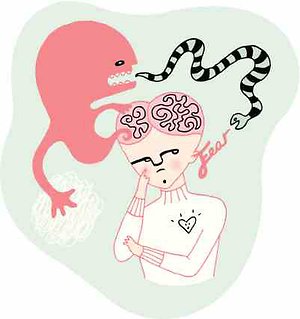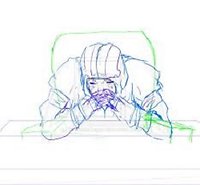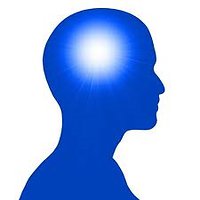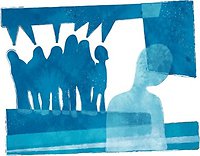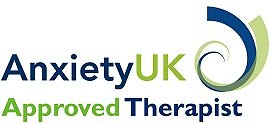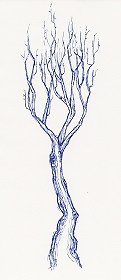Generalised Anxiety Disorder and Worry (GAD) a CBT Perspective
Have you always been a worrier? If there is nothing to worry about do you 'worry about worry'? Do minor everyday events spiral into major concerns? Once worry starts is your worry hard to stop? Do you often feel as if something awful is about to happen? Does worry stop you enjoying life?
Most of us experience bouts of severe worry from time to time, there are many things to fear in life and not worrying would be a mistake, however, excessive prolonged emotions are likely to cause dysfunction in our lives. If you experience severe levels of excessive anxiety and worry about a wide range of things over long periods of time you may have GAD (Generalised Anxiety Disorder) About one person in twenty-five has enough symptoms to receive a diagnosis of GAD each year. However, we often hide our worries in case people think we are crazy or pathetic. Research demonstrates a strong overlap between all syndromes related to anxiety and about 70% of people with GAD also report depression at some point in their lives.
A whirlwind of worrying thoughts produces anxiety and distressing physical symptoms such as pounding heart, sweating, tingling and numbness in fingers and toes, stomach-churning 'butterflies' tense muscles and feeling dizzy and lightheaded among others. Caused by the release of adrenalin and other hormones; our bodies evolutionary Fight Flight or Freeze response to threat danger and vulnerability. Worry also manifests in strong negative thoughts images and unhelpful behaviour and when the crisis in our mind has passed we feel exhausted.
Some of us are more likely to experience excessive anxiety due to our genetic and physiological makeup and our early life experiences. We tend to start having problems with worry when we are young and trying to lay the foundations of a secure sense of self. Our worries tend to cluster around particular areas that are important to us like health, relationships, finance, family work and study and typically mirror the life stage we are in.
We can learn to keep worry in proportion and deal with it differently.
Most of us experience bouts of severe worry from time to time, there are many things to fear in life and not worrying would be a mistake, however, excessive prolonged emotions are likely to cause dysfunction in our lives. If you experience severe levels of excessive anxiety and worry about a wide range of things over long periods of time you may have GAD (Generalised Anxiety Disorder) About one person in twenty-five has enough symptoms to receive a diagnosis of GAD each year. However, we often hide our worries in case people think we are crazy or pathetic. Research demonstrates a strong overlap between all syndromes related to anxiety and about 70% of people with GAD also report depression at some point in their lives.
A whirlwind of worrying thoughts produces anxiety and distressing physical symptoms such as pounding heart, sweating, tingling and numbness in fingers and toes, stomach-churning 'butterflies' tense muscles and feeling dizzy and lightheaded among others. Caused by the release of adrenalin and other hormones; our bodies evolutionary Fight Flight or Freeze response to threat danger and vulnerability. Worry also manifests in strong negative thoughts images and unhelpful behaviour and when the crisis in our mind has passed we feel exhausted.
Some of us are more likely to experience excessive anxiety due to our genetic and physiological makeup and our early life experiences. We tend to start having problems with worry when we are young and trying to lay the foundations of a secure sense of self. Our worries tend to cluster around particular areas that are important to us like health, relationships, finance, family work and study and typically mirror the life stage we are in.
We can learn to keep worry in proportion and deal with it differently.
Uncertainty, Real and 'Hypothetical' Worries & Our Beliefs about Worry
CBT identifies three main aspects to worry understanding uncertainty distinguishing between real and hypothetical worries and our beliefs about worry
Uncertainty
There are times in life when the uncertainty of not knowing is the hardest part and almost unbearable to tolerate. Uncertainty though is a constant feature in our lives, we manage it mostly with only a passing thought to 'what if' and cope with it often even without realising it. People who worry excessively seem to find it harder to tolerate uncertainty and spend huge amounts of time thinking 'what if' Even small daily events can produce extreme levels of anxiety 'what if' thoughts images and fears trigger a whirlwind of worry which can spiral into something different to the original worry and we get caught up in overwhelming catastrophic thoughts that could happen rather than what is happening in the present.
Trying to keep things safe by avoiding uncertainty limits our lives and those of others. A consequence of living this way may be low mood and depression.
Are there advantages to accepting a little more uncertainty? Could there be disadvantages?
We can begin to take small manageable steps to introduce a little uncertainty into our lives. We could ask loved ones not to tell us precisely when they may be home. We could try stopping asking for reassurance. We could let the children do age appropriate things for themselves even if they don't get it quite right. We could try delegating small tasks and committing ourselves to something new.
Changing our behaviour is about finding out something new by doing something differently. We are likely to feel more anxious at first anxiety does though wear off if we expose ourselves to the things we worry most about. We need also to be kind and less critical of ourselves.
Positive and Negative Beliefs about Worry
CBT outlines positive and negative beliefs about worry. Positive beliefs about worry make us think that worry is useful.
Does worry keep us and others safe? Are there other ways to show we care?
If we keep up this level of worry the likelihood is that we will feel too stressed out to cope with anything.
Negative beliefs about worry like I am out of control, I am going crazy, I am weak I feel overwhelmed I cannot focus make us more anxious driving the worry on. It makes sense to reality test these thoughts by challenging them. Have I gone crazy before how did I stop my self?
Real and 'Hypothetical' Worries
Sometimes it is hard to tell the difference between real and hypothetical worries many of our worries are realistic
Perhaps a brainstorming, practical solution finding, problem solving approach and a firm action plan may be called for.
We need to become aware of when real event worries escalate to 'what if' 'hypothetical' worries and separate them out. In reality most of the clients I see with GAD manage to cope very well with real worries their skills are not lacking just their beliefs about their ability to cope.
We cannot however, solve a problem that just exists in our imagination.
We tend to worry when we are alone with our thoughts and in the early hours. Our thoughts race making us feel as though we are in chaos and we underestimate our ability to cope. Worry promotes us to be over protective loved ones experience us as nagging, intrusive and in constant need of reassurance. We imagine scenarios that could happen, haven't happened yet and most likely will not happen. We do not allow ourselves to enjoy life in the here and now.
A consequence of living this way may be low mood and depression.
Trying to distract suppress or avoid worries may help for a bit however, often we just end up worrying more; because worry will find a way of getting at us as it is likely linked to some unfinished business that demand our attention.
While scary to contemplate; the solution is to confront or expose ourselves to our fears to face the real thoughts and images within the worry itself.
By concentrating on our worries, perhaps by diary writing and staying with the fear until anxiety comes down as it will without us doing anything at all, we can begin to realise that there may not be anything to fear. We can work through our 'hypothetical' worries this way one by one. Learning to sit with anxiety and uncertainty does not mean we are uncaring it means we can begin to tell the difference between thoughts and reality and gradually these fears will become more manageable.
Uncertainty
There are times in life when the uncertainty of not knowing is the hardest part and almost unbearable to tolerate. Uncertainty though is a constant feature in our lives, we manage it mostly with only a passing thought to 'what if' and cope with it often even without realising it. People who worry excessively seem to find it harder to tolerate uncertainty and spend huge amounts of time thinking 'what if' Even small daily events can produce extreme levels of anxiety 'what if' thoughts images and fears trigger a whirlwind of worry which can spiral into something different to the original worry and we get caught up in overwhelming catastrophic thoughts that could happen rather than what is happening in the present.
Trying to keep things safe by avoiding uncertainty limits our lives and those of others. A consequence of living this way may be low mood and depression.
Are there advantages to accepting a little more uncertainty? Could there be disadvantages?
We can begin to take small manageable steps to introduce a little uncertainty into our lives. We could ask loved ones not to tell us precisely when they may be home. We could try stopping asking for reassurance. We could let the children do age appropriate things for themselves even if they don't get it quite right. We could try delegating small tasks and committing ourselves to something new.
Changing our behaviour is about finding out something new by doing something differently. We are likely to feel more anxious at first anxiety does though wear off if we expose ourselves to the things we worry most about. We need also to be kind and less critical of ourselves.
Positive and Negative Beliefs about Worry
CBT outlines positive and negative beliefs about worry. Positive beliefs about worry make us think that worry is useful.
- We may think that worry helps us to focus and find solutions to problems.
- Someone has to do the worrying it shows we care if we didn't it would mean that we are unfeeling.
- If we don't worry by an odd kind of logic we are tempting fate and fate will get back at us by making something awful happen we believe worry will
- catastrophic events.
- If we worry enough we are prepared for the worst so that if something awful does happen we are
- from the shock and will be able to cope with it better.
Does worry keep us and others safe? Are there other ways to show we care?
If we keep up this level of worry the likelihood is that we will feel too stressed out to cope with anything.
Negative beliefs about worry like I am out of control, I am going crazy, I am weak I feel overwhelmed I cannot focus make us more anxious driving the worry on. It makes sense to reality test these thoughts by challenging them. Have I gone crazy before how did I stop my self?
Real and 'Hypothetical' Worries
Sometimes it is hard to tell the difference between real and hypothetical worries many of our worries are realistic
- Is what I am worrying about something that exists now?
- Is it something I can do something about. How what When?
- Could something be done about it?
- Is it solvable?
- Could someone else solve it?
Perhaps a brainstorming, practical solution finding, problem solving approach and a firm action plan may be called for.
We need to become aware of when real event worries escalate to 'what if' 'hypothetical' worries and separate them out. In reality most of the clients I see with GAD manage to cope very well with real worries their skills are not lacking just their beliefs about their ability to cope.
We cannot however, solve a problem that just exists in our imagination.
We tend to worry when we are alone with our thoughts and in the early hours. Our thoughts race making us feel as though we are in chaos and we underestimate our ability to cope. Worry promotes us to be over protective loved ones experience us as nagging, intrusive and in constant need of reassurance. We imagine scenarios that could happen, haven't happened yet and most likely will not happen. We do not allow ourselves to enjoy life in the here and now.
A consequence of living this way may be low mood and depression.
Trying to distract suppress or avoid worries may help for a bit however, often we just end up worrying more; because worry will find a way of getting at us as it is likely linked to some unfinished business that demand our attention.
While scary to contemplate; the solution is to confront or expose ourselves to our fears to face the real thoughts and images within the worry itself.
By concentrating on our worries, perhaps by diary writing and staying with the fear until anxiety comes down as it will without us doing anything at all, we can begin to realise that there may not be anything to fear. We can work through our 'hypothetical' worries this way one by one. Learning to sit with anxiety and uncertainty does not mean we are uncaring it means we can begin to tell the difference between thoughts and reality and gradually these fears will become more manageable.
NICE (National Institute of Clinical Excellence) recommends CBT as the treatment of choice for GAD. I have summarised the main considerations of a CBT approach. I hope you have learned a little about your own worries you can find out more by keeping a worry diary. Face to Face therapy is available from NHS Psychological Services and privately. Good luck!
Panic Disorder a Cognitive Behavioural Therapy (CBT) Approach
Most of us experience anxiety, it is like a signal to us that we are under threat are vulnerable and in danger and need to take action, it is a natural and necessary response. Anxiety is a primitive survival mechanism, as we were evolving life was hard, with severe competition for food and shelter. Danger was mainly of a physical nature so we developed the fight flight or freeze response. The moment we suspect danger adrenalin and other hormones are released resulting in physiological changes.
Nowadays many of the situations we face do not require a physical response and anxiety can become very unhelpful when it takes over our thinking processes and our lives making it difficult to function. Anxiety has become out of all proportion to the reality of the situation. Anxiety disorders are characterised by intrusive thoughts/images, avoidance, 'safety seeking behaviours', low mood and worry. Growing up in a difficult insecure environment can make us more vulnerable to developing anxiety problems; early life experiences lead us to develop an underlying set of core beliefs that make us more prone to anxiety. Triggers in our lives including being bullied, financial difficulties, serious illness, critical incidents and loss may have a more severe effect if we are already prone to anxiety. There is research suggesting that anxiety problems may be inherited. It is the interplay between our thoughts feelings and behaviours that allow anxiety problems to persit.
Anyone can have a panic attack given the right circumstances, research has demonstrated that one in ten of us will have at least one panic attack in a year however; we often feel that we cannot talk of our experiences. Panic is defined as a sudden rush of physical symptoms that reach a peak within a few minutes including: chest pain, palpitations, breathlessness, dizziness, trembling, sweating, a feeling of choking, dry mouth, nausea, numbness or tingling particularly in our lips and fingers, feeling unreal, chills, hot flushes and fears of dying losing control or going crazy. At least four of these symptoms need to be experienced for an anxiety attack to be diagnosed as a panic attack. Panic disorder is diagnosed if we experience frequent panics 'coming out of the blue'. If we have panicked in a particular situation and are fearful of returning we may develop 'panic disorder with agoraphobia' "adapted from Improving Access to Psychological Therapies" The attacks are not always triggered by expecting a particular situation, going into a situation or a sudden increase in the severity of a specific situation. The main fear in panic disorder is the fear of having a panic attack.
A slight bodily sensation, an upsetting thought or going somewhere a panic has happened before can lead to worry that something is seriously wrong. The sensations that we experience lead us to think catastrophic thoughts 'I am going mad' 'I am losing control' 'I am going to die'. As a result of these thoughts there is an increase in anxiety resulting in an escalation in bodily sensations from adrenalin, more worry and more symptoms and we have a vicious maintenance cycle.
Because we believe disaster is about to strike it is understandable that we experience so much fear in and before a panic attack. Learning about the role of thinking in all anxiety disorders and working on 'maintenance factors' is the cornerstone of Cognitive Behavioural Therapy (CBT) interventions, recommended as the treatment of choice for anxiety disorders by The National Institute of Clinical Excellence NICE
We need to learn to distinguish between whether the problem is real, "I have a serious illness" or "I am not in danger" could there be another explanation for my symptoms. The problem is that we are 'misinterpreting' the situation. There are a number of factors that keep panic disorder going. Evidence and Symptoms Write down all of your symptoms and explore whether there is another explanation e.g. I am going to faint. It is a sudden drop in our blood pressure that causes us to faint whereas; anxiety causes our heart to pump faster and our blood pressure to rise. What evidence do I have that my symptoms mean a catastrophic outcome? Hyper vigilance We become alert to every sensation that others would not notice or would just ignore. Do other strong feelings like anger and intense pleasure induce powerful sensations? The main difference is the thoughts we attach to panic. Avoidance & 'Safety Seeking Behaviours' 'I must sit down to avoid a heart attack' 'I cannot travel more than an hour from home I have to keep myself safe' 'I cannot travel alone'. Try writing down all of the 'safety seeking behaviours' that you have adopted. Images Many of us also have mental pictures we carry around with us of our worse fear of what could happen accompanied by strong emotions. We can practise changing these images.
Panic disorder is an 'abnormal' reaction it takes over our thinking processes and dominates and severely limits our lives. To overcome panic disorder we need to learn 'logically' and through our experience that sensations in a panic attack won't harm us even if we don't use our precautions. To do this we have to put ourselves many times in situations which make us anxious. There are some very useful self-help guides, some available on the GP library prescription scheme. Support from those we are close to will be crucial. Help is also available from NHS Psychological Services and privately. Good Luck!
Social Phobia a CBT Approach
Most of us can remember occasions when we have felt embarrassed by something we have said or made a fool of ourselves in public. Common manageable social anxiety is usual and even useful.
Social phobia is a more extreme and persistent kind of social anxiety. If we have social phobia we feel apprehensive and nervous interacting with others, or feel uncomfortable in their presence, making it hard to feel at ease around others and to be spontaneous and natural in conversation. Talking to others or thinking we are being observed can be enough to make someone who is socially phobic feel worried and self-conscious. Social phobia interferes with our lives in debilitating ways stopping us doing the things we may like to do and being the sort of person we know we can be.
There is no hard and fast way of diagnosing social phobia. It seems to affect men and woman roughly equally, is influenced by cultural norms and often becomes apparent in adolescence.
Sadly people with social phobia seem to find it especially hard asking for help, and while realistically we are unlikely to reach a place where we never experience socially anxious feelings again, there is a huge amount we can learn understand and practise giving us an excellent chance of bringing about valuable and lasting change.
It is possible to learn to express ourselves in ways that may previously have been stifled by feeling anxious and to enjoy rather than fear being ourselves in what may currently seem like socially dangerous situations.
If you want to do something about your social phobia then a starting point is to understand how social phobia affects you personally and how it is exacerbated.
We experience four kinds of symptoms that are closely linked creating a vicious maintenance cycle.
Social phobia is a more extreme and persistent kind of social anxiety. If we have social phobia we feel apprehensive and nervous interacting with others, or feel uncomfortable in their presence, making it hard to feel at ease around others and to be spontaneous and natural in conversation. Talking to others or thinking we are being observed can be enough to make someone who is socially phobic feel worried and self-conscious. Social phobia interferes with our lives in debilitating ways stopping us doing the things we may like to do and being the sort of person we know we can be.
There is no hard and fast way of diagnosing social phobia. It seems to affect men and woman roughly equally, is influenced by cultural norms and often becomes apparent in adolescence.
Sadly people with social phobia seem to find it especially hard asking for help, and while realistically we are unlikely to reach a place where we never experience socially anxious feelings again, there is a huge amount we can learn understand and practise giving us an excellent chance of bringing about valuable and lasting change.
It is possible to learn to express ourselves in ways that may previously have been stifled by feeling anxious and to enjoy rather than fear being ourselves in what may currently seem like socially dangerous situations.
If you want to do something about your social phobia then a starting point is to understand how social phobia affects you personally and how it is exacerbated.
We experience four kinds of symptoms that are closely linked creating a vicious maintenance cycle.
- Social phobia affects us physically: excessive sweating, racing heart, shaking or trembling blushing tension etc.
- Our moods or feelings: typically panicky feelings, nervousness, fear, apprehension, irritation, shame, anger, frustration, sadness, depression and feeling hopeless.
- We are likely to be aware of and most concerned by our bodily sensations and our feelings. However, our thoughts like worrying about what others think of us make us painfully self-conscious and hyper self- aware. We ruminate on things that we think that we did wrong believing or assuming that we are inadequate.
- Safety seeking behaviours: such as avoiding people, places, activities, escaping from difficult situations, protecting ourselves from things we fear and trying not to attract attention.
I am sure you can add other symptoms of your own.
Cognitive Behavioural Therapy (CBT) is recommended by NICE (The National Institute for Clinical Excellence) for the treatment of all the anxiety disorders.
Self-consciousness thinking patterns, safety behaviours, low confidence, low mood and depression and dissecting a social situation afterwards perpetuate our problem
It is hardly surprising that we may experience low mood and depression. Social phobia gets us down as it interferes with what we want to do and being the sort of person we want to be. Working on our social phobia can help alleviate low mood and depression
Confidence can be built from doing things and not worrying too much if we get it wrong mistakes help us to learn. Working on our social phobia will help build our confidence in all sorts of ways.
Most of us look back and dissect a social situation once it is over. We cringe as the memory comes back to us and it brings on all the bad feelings. The problem is our memory is affected by our anxiety, we remember and ruminate on what we think happened reinforcing our negative views of our self. Clearly this is not helpful to us, perhaps the key is to reflect on our experiences without judgement or to do or think of something pleasant instead.
So we have a trigger social situation. Our patterns of thinking which are hidden in our beliefs and assumptions are activated ‘I am a failure’ ‘everyone is criticising me’. We see the situation as socially dangerous we become very self-conscious, focusing all our attention on ourselves, we experience our signs and symptoms and resort to our safety seeking behaviours
Self-consciousness
Self-consciousness is a normal human emotion that we all feel when we become aware of the scrutiny of others; but when it is excessive it can seriously inhibit our social performance and enjoyment of social interactions.
Self-consciousness and concern about how we are perceived by others seems to be a unique feature of social phobia; normally when we face our fears the fear dies away but in social phobia this seems not to happen, simply facing others appears not to reduce the fear of meeting or interacting with them. Maybe this is because we often cannot know for certain what others are thinking of us.
Self-consciousness comes from focusing our attention inwards and becoming acutely aware of what is going on in our minds and our bodies making us feel worse and the social situation feel even more dangerous; meaning that we will find it almost impossible to interact comfortably with others. We may focus internally because we think that we need to monitor how we feel in order to estimate how badly we are coming across. The problem with our perception is that it may not be accurate as we do not necessarily come across as we feel. We are far more likely to get an accurate sense of how we are coming across by focusing externally than internally.
CBT places great emphasis on learning experimenting and practising doing things differently. So the idea here is to learn and practise giving more attention to the people we are interacting with so that eventually we can become confident, attentive, comfortable and natural in social situations.
Focussing externally is something we do all the time, when we are interested and absorbed in activities that take our attention; we lose ourselves in the process: like watching a film, being engrossed in a hobby, computer games, walking reading a book etc. We can begin by practising switching our attention from internal what is going on in our mind and our body to external what is happening around us, starting with people we feel safe with in non-threatening situations. Notice the difference between the two kinds of attention. Being involved with something external to ourselves; the more interesting to us the easier it is to focus less on ourselves. It is likely that focusing externally makes us feel better than focusing internally. Gradually we will need to practise focusing externally in more threatening situations. No doubt it will feel hard at first and our mind will wander back to our own anxieties however, it is worth reminding ourselves of our goals and with perseverance focusing externally in social situations can become a habit. Paradoxically we kind of need to learn to forget ourselves in order to find ourselves.
Self-consciousness and concern about how we are perceived by others seems to be a unique feature of social phobia; normally when we face our fears the fear dies away but in social phobia this seems not to happen, simply facing others appears not to reduce the fear of meeting or interacting with them. Maybe this is because we often cannot know for certain what others are thinking of us.
Self-consciousness comes from focusing our attention inwards and becoming acutely aware of what is going on in our minds and our bodies making us feel worse and the social situation feel even more dangerous; meaning that we will find it almost impossible to interact comfortably with others. We may focus internally because we think that we need to monitor how we feel in order to estimate how badly we are coming across. The problem with our perception is that it may not be accurate as we do not necessarily come across as we feel. We are far more likely to get an accurate sense of how we are coming across by focusing externally than internally.
CBT places great emphasis on learning experimenting and practising doing things differently. So the idea here is to learn and practise giving more attention to the people we are interacting with so that eventually we can become confident, attentive, comfortable and natural in social situations.
Focussing externally is something we do all the time, when we are interested and absorbed in activities that take our attention; we lose ourselves in the process: like watching a film, being engrossed in a hobby, computer games, walking reading a book etc. We can begin by practising switching our attention from internal what is going on in our mind and our body to external what is happening around us, starting with people we feel safe with in non-threatening situations. Notice the difference between the two kinds of attention. Being involved with something external to ourselves; the more interesting to us the easier it is to focus less on ourselves. It is likely that focusing externally makes us feel better than focusing internally. Gradually we will need to practise focusing externally in more threatening situations. No doubt it will feel hard at first and our mind will wander back to our own anxieties however, it is worth reminding ourselves of our goals and with perseverance focusing externally in social situations can become a habit. Paradoxically we kind of need to learn to forget ourselves in order to find ourselves.
Thoughts
If we suffer with social anxiety we are likely to experience familiar thought patterns
Emotional reasoning- Meaning that we use our feelings as evidence for how we are coming across in social situations. In reality our anxiety may not be obvious to others; in the same way that someone cannot tell if we are hungry or thirsty. While we can guess what someone is feeling we cannot know for sure unless we ask
Taking too much responsibility- We often think it is totally our responsibility for how a social interaction goes when in reality the responsibility is shared.
Overly high standards for social performance- Such as expecting we should be interesting all the time, keep the conversation going, not dry up and to remember what we are talking about. It is worth observing that we all make ‘social mistakes’ and is anyone really bothered?
We often have similar thoughts for a number of reasons like we are boring uninteresting and unlikeable. In reality accepting and liking someone is more about the match between individuals, the chemistry which may be out of our awareness and not about our competencies.
“They will see how nervous I am”, “they will criticise me”, “I’ll do or say something stupid” “I’ll make a fool of myself” “I won’t think of anything to say” It is negative predictions like these that make social life feel so threatening. We are so preoccupied with our thoughts we become stilted and awkward and are bound to feel strong feelings finding it hard to relax and talk freely. We experience so much anxiety we may actually end up doing exactly what we most hope not to.
We can tune into what we are saying to ourselves before during and after a social interaction. We can log our thoughts; describing the trigger situation, our feelings, and our thoughts beliefs and assumptions. We can then begin to examine the validity and helpfulness of our thoughts by introducing a more balanced realistic view. We can devise experiments that are SMART specific, measurable, achievable realistic and time limited. If you want to try and tackle your social anxiety yourself the NTW has some useful worksheets.
Emotional reasoning- Meaning that we use our feelings as evidence for how we are coming across in social situations. In reality our anxiety may not be obvious to others; in the same way that someone cannot tell if we are hungry or thirsty. While we can guess what someone is feeling we cannot know for sure unless we ask
Taking too much responsibility- We often think it is totally our responsibility for how a social interaction goes when in reality the responsibility is shared.
Overly high standards for social performance- Such as expecting we should be interesting all the time, keep the conversation going, not dry up and to remember what we are talking about. It is worth observing that we all make ‘social mistakes’ and is anyone really bothered?
We often have similar thoughts for a number of reasons like we are boring uninteresting and unlikeable. In reality accepting and liking someone is more about the match between individuals, the chemistry which may be out of our awareness and not about our competencies.
“They will see how nervous I am”, “they will criticise me”, “I’ll do or say something stupid” “I’ll make a fool of myself” “I won’t think of anything to say” It is negative predictions like these that make social life feel so threatening. We are so preoccupied with our thoughts we become stilted and awkward and are bound to feel strong feelings finding it hard to relax and talk freely. We experience so much anxiety we may actually end up doing exactly what we most hope not to.
- What am I troubled about?
- What is the worst that can happen?
- Am I afraid others will see particular symptoms like trembling sweating and blushing?
We can tune into what we are saying to ourselves before during and after a social interaction. We can log our thoughts; describing the trigger situation, our feelings, and our thoughts beliefs and assumptions. We can then begin to examine the validity and helpfulness of our thoughts by introducing a more balanced realistic view. We can devise experiments that are SMART specific, measurable, achievable realistic and time limited. If you want to try and tackle your social anxiety yourself the NTW has some useful worksheets.
Safety Behaviours
It is natural for us to try and keep ourselves safe if we are facing risk threat and danger. From time to time we have all experienced overwhelmingly anxious feelings and experienced a huge temptation to keep ourselves safe by avoiding certain situations.
Safety seeking behaviours describe the activities we have adopted to try and keep ourselves safe from fear of being humiliated, criticised, embarrassed or rejected in social situations: - always taking someone with us, wearing earphones at work to avoid social interaction, holding our arms stiffly to avoid the shaking we fear to total avoidance of all social interactions. Unfortunately our endeavours only offer temporary relief and are likely to backfire making us more self-conscious linking up with our negative thoughts creating further anxiety and like a bad habit making our social anxiety even worse.
We can only find out that the social situation is not as fearful as we thought and to begin to build our confidence if we get out there and test our expectations. Gradually we can build up evidence using day to day opportunity carrying out experiments and collecting the data to check the validity and accuracy of our negative predictions
CBT is an inherently positive, hope confirming here and now approach. It is not the only talking therapy available for treating anxiety difficulties. However, CBT lends itself to randomized controlled trials: the methodology The National Institute of Clinical Excellence (NICE) currently relies upon to evaluate the effectiveness and efficacy of treatments for use in the NHS.
While those of us experiencing social anxiety seem to find difficulty in asking for help it seems worth facing our initial fears for the long term potential gains we stand to make. There is help available from NHS Psychological Services and privately. Good Luck!
Safety seeking behaviours describe the activities we have adopted to try and keep ourselves safe from fear of being humiliated, criticised, embarrassed or rejected in social situations: - always taking someone with us, wearing earphones at work to avoid social interaction, holding our arms stiffly to avoid the shaking we fear to total avoidance of all social interactions. Unfortunately our endeavours only offer temporary relief and are likely to backfire making us more self-conscious linking up with our negative thoughts creating further anxiety and like a bad habit making our social anxiety even worse.
We can only find out that the social situation is not as fearful as we thought and to begin to build our confidence if we get out there and test our expectations. Gradually we can build up evidence using day to day opportunity carrying out experiments and collecting the data to check the validity and accuracy of our negative predictions
CBT is an inherently positive, hope confirming here and now approach. It is not the only talking therapy available for treating anxiety difficulties. However, CBT lends itself to randomized controlled trials: the methodology The National Institute of Clinical Excellence (NICE) currently relies upon to evaluate the effectiveness and efficacy of treatments for use in the NHS.
While those of us experiencing social anxiety seem to find difficulty in asking for help it seems worth facing our initial fears for the long term potential gains we stand to make. There is help available from NHS Psychological Services and privately. Good Luck!
You are welcome to contact us Email

